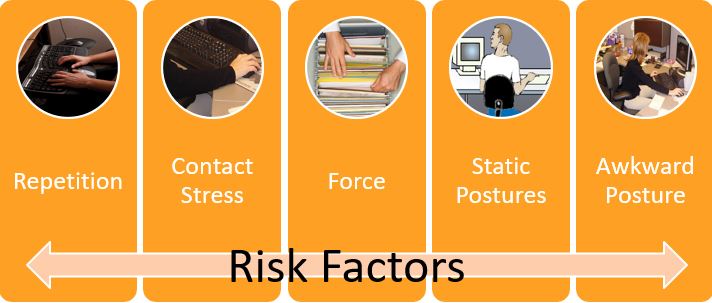6 Ergonomic Risk Factors To Look For
What are Ergonomic Risk Factors? These are workplace situations that cause wear and tear on the body and can cause injury. There are many different ways to break up the risk factors that can be found in the workplace. However, here at WorkSafe Physical Therapy, we focus on 6 key risk factors. These ergonomic risk factors include awkward posture, force, repetition, static work, contact stress, and Vibration. Each one separately presents a risk to musculoskeletal injury but when combined the likelihood of injury goes up even more.
Being able to recognize these risk factors in your workplace is a great way to start a better safety program and keep employees healthy.
Awkward Body Postures
The awkward body posture risk factor is defined as maintaining an unsupported static posture or performing an awkward posture such as bending, reaching, or twisting. This happens when body parts are positioned away from their neutral position. The longer the awkward posture is sustained the higher risk for injury. Some examples of awkward postures include flexion/extension of the wrist, excess abduction of the shoulders. Forward flexion of the shoulders (reaching forward), and bending or twisting at the waist or neck. The goal is to maintain a neutral body position and to keep your arms and legs as close to your trunk as possible.

Force
Force is defined as physical exertion or pressure applied to any body part while working such as grip, pinch, push/pull, lift or carry. Due to muscle effort increasing when forceful activities are done, the muscles will fatigue and be at a higher risk of injury as a result. Examples of force in the workplace include pushing or pulling a heavy load, gripping a knife, and lifting or carrying a heavy load.
Repetition
Repetition is defined as doing the same motions over and over again. The severity of the risk increases with a higher repetition of motions, particularly when combined with other risk factors such as force and or an awkward posture. Repetition can be seen with doing the same movements or a combination of movements for the duration of the day. Repetition is also seen when doing different movements but using the same groups of muscles throughout the day. A job is considered highly repetitive if the cycle time is 30 seconds or less. Some examples of repetitive movements in the workplace are typing or using a mouse, reaching overhead to place items on a conveyor line, or drilling into a substance in the manufacturing process.
Static Work
Static work is defined as maintaining the same position for several hours a day. The human body was made to move and staying in one position for the duration or even several hours at a time can be detrimental. Examples of static work include standing in place, sitting at the computer, or holding the framing pieces up at a construction site. Even those that work on an assembly line can suffer from static work postures due to holding a tool for a prolonged time period.
Contact Stress
Contact stress is defined as happening when some part of a worker’s body (knees, elbows, or wrists for example) touch or rub up against a hard, sharp, or inflexible surface for an extended period of time or repetitively. Surfaces could be a tool, workstation, the floor, or a ladder. Localized pressure from the surface against soft body tissue can affect nerve function, movement of tendons and muscles, or blood flow.

Examples of mechanical contact stress in the workplace include resting forearms on a desk edge or leaning against a workstation with a sharp corner.
Vibration
Vibration as a risk factor is defined as when the body is exposed to pulsation, shaking, or tremors typically produced by a vibrating object such as a power hand tool. There are two different subcategories of vibration, arm-hand vibration and whole-body vibration. Vibration limits the blood supply to the hands and fingers resulting in musculoskeletal disorders such as carpal tunnel and occupational Raynaud’s syndrome. Whole-body vibration has been linked to shoulder and neck stiffness and musculoskeletal disorders.

Reduce Ergonomic Risk Factors in the Wichita Area with WorkSafe PT
If you look around your company and notice one or more of these risk factors happening then now is the time to proactively fix these and keep your employees safe. At WorkSafe PT we have a staff of Physical Therapists that are trained in ergonomic assessments and have years of education under their belts in analyzing the human body and how it moves. These two things combined make our physical therapists experts at identifying risks in the workplace that might lead to discomfort and injury.
Contact WorkSafe Physical Therapy to find out how we can help your company reduce ergonomic risk factors in Wichita and surrounding areas.
Related Articles to Ergonomic Risk Factors
References for Ergonomic Risk Factors in the Workplace
Charles LE, Ma CC, Burchfiel CM, Dong RG. Vibration and Ergonomic Exposures Associated With Musculoskeletal Disorders of the Shoulder and Neck. Saf Health Work. 2018;9(2):125-132. doi:10.1016/j.shaw.2017.10.003
